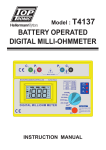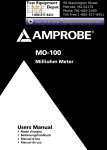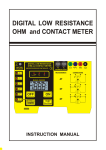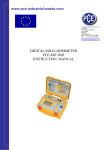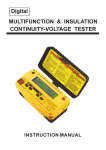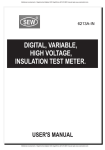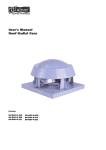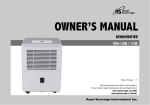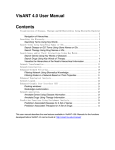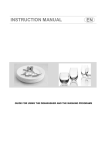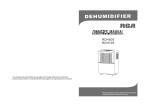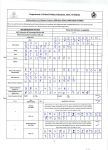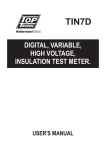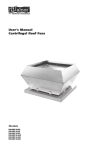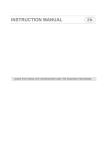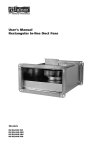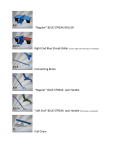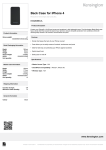Download 310 - Digital Milli-Ohm Meter
Transcript
Instruction Manual Model 310 Digital Milli-Ohm Meter DESCRIPTION SAFETY RULES.................................................... PAGE 01 GENERAL DESCRIPTION.................................... 02-03 FRONT PANEL LAYOUT....................................... 04 PREPARATION FOR USE.................................... 05 PRELIMINARY CHECKS...................................... 05 PRECAUTIONS..................................................... 06 MEASURING......................................................... 07 SIMPLIFIED MEASUREMENT.............................. 08 APPLICATIONS..................................................... 09 TEST LEADS......................................................... 10 THERMAL EFFECTS............................................ 11 FUSES REPLACEMENT....................................... 12 INPUT LIMITS & PROTECTIONS......................... 13 SPECIFICATIONS................................................. 14 SPARES & ACCESSORIES.................................. 15 LIMITED ONE-YEAR WARRANTY........................ 15 CLEANING & STORAGE...................................... 16 BATTERY & FUSE REPLACEMENT..................... 16 SERVICE INFORMATION.................................... 17 SAFETY RULES The meter has been designed with safety in mind. However, no design can completely protect against incorrect use. Electrical circuits are dangerous and lethal through lack of caution or poor safety practice. The following rules should reduce the danger • Read the User's manual carefully and completely before using the instrument. Fully understand the instructions before using this product. Follow the instructions for every test. Take all the necessary precautions. Do not exceed the limits of this instrument. • The circuit to be tested must be de-energised and isolated before connections are made to it. • Do not use test leads, probes or crocodiles/aligators clips that are dirty, damaged or have broken or cracked insulation. Such accessories should be removed and repaired Immediately. • Always disconnect the test leads before replacing any fuse Always replace the fuse with the type specified and ensure that they are correctly fitted. • Double check the switch settings and leads connections before measuring. Make a sketch to ensure proper operation and principle of measurement is correct and well understood. • Do not touch any exposed wiring, connections or other "live" parts of an electrical circuit. If in doubt, check the circuit first for voltage before touching it. • This instrument should only be used by a competent, suitably trained person which understand fully this test & measurement procedure. Warning, risk of electric shock. Caution, refer to this manual before using the Meter. -1- GENERAL DESCRIPTION The meter digital milli-ohmmeter is a battery operated instrument wich supply a low current to the circuit under test, with which, stable, accurate measurement of low resistance can be made, still, over a wide range of values. Resolution on the lowest range is 100µ ohm and on the highest range, 1 ohm. The meter has 5 measuring ranges, from 200.0milli-ohm to 2000 ohms. Measurements are displayed on a 3½ digit custom liquid crystal display with large digits. This instrument is powered from batteries only ( alkaline or rechargeable equivalent). It has a regulated DC constant current source with current of 1mA 10mA and 100mA. The instrument supply that current to the resistance being measured through the C1 and C2 terminals (C1 being +, C2 being -). The voltage drop across the resistance under test is measured by the potential terminals P1 and P2 (P1 being +, P2 being -). Should the current regulation drops out, the RC Led will lit, indicating that the resistance in the current circuit is too high. (Lowering the current by selecting a higher resistance range can solve the regulation.) Should the RP Led lit, that mean that the voltage measured on the resistance is too high, and therefore over-range. The resistance is measured precisely when the RP and RC Leds do not lit. If anyone of these leds lit, then the measurement can be inaccurate. -2- The meter has a built-in custom 3½ digit liquid crystal display can be viewed in most lightning conditions. This display indicates the diferentes conditions (Hold, m, buzzer, polarity condition of load, + or -, automatic decimal point change). The ranges are selected by a 5 position rotary switch, and a test is initiated by pressing the ON push-button. The instrument takes measurements for 10 seconds if the "ON" "TEST re" presentative" button is depressed for less than 2 seconds. If the same push button is pressed for more than 3 seconds, the test will carry on for 60 seconds. The tester switch "OFF" completely when the rotary switch is in the "OFF" position. The tester "Hold" the last reading before stopping the test. The tester is fuse protected and has a crowbar between C1 and C2. This crowbar is activated by voltage. If the voltage is too high, that crowbar will blow the fuse automatically to interrupt the circuit. The voltage between P1 and P2 is also protected for over voltage but does not have a fuse. The tester has a temperature shut down. The temperature sensing is done on the current regulation transistor. Should this over-temperature let lit, allow the instrument to cool down for a while before proceeding further. -3- FRONT PANEL LAYOUT If NO TEST LED lit, the current source is stopped. NO TEST RP RC Over Temperature indicator. Lit = Over-temperature or test stopped. Resistance between the current leads too high (fuse!). Resistance between the potential leads too high. Current Injection Terminals Potential Injection Terminals C1 P1 P2 C2 MAX. DC20V MICROPROCESSOR CONTROLLED HOLD AC DC MAX MIN AUTO-HOLD Test Current Range 2000 W 1mA 200.0 W 10mA 20.00 W 10mA 2000m W 100mA 100mA 200.0m W Hz mV kMW NO TEST RP RC 2000 200.0 kA ms 20.00 2000m 200.0m DIGITAL MILLIOHM METER OFF EnerSave TM TEST R P ON Ÿ Short Test duration if TEST is depressed for less than 2Sec. Ÿ Long Test Duration if TEST is depressed for more than 3Sec. Current/Range Table Start/Stop Test Liquid Crystal Display Rotary Selector Switch Meet LVD & EMC requirements -4- PREPARATION FOR USE When unpacked, the tester should be inspected for any visible signs of damage, and the preliminary checks described in the user's manual should be performed to ensure that it is operating correctly. If there is any sign of damage, or if the instrument does not operate correctly, return it to your nearest supplier. PRELIMINARY CHECKS Check the battery • If the battery symbol is shown on the LCD, then replace the batteries with new alkalines batteries before proceeding. Check the current regulation: • Connect the current leads to C1 and C2. • Select a range, and short the current test leads. The RC led should go off, indicating that the current regulation is ok. Check the voltage measurement: • Connect the potential leads to P1 and P2. • Short the P1 and P2. The display should indicate 0000. • Remove the short from P1 and P2and C1 and C2 . Touching the potential test leads P1 to C1 and P2 to C2, the RP led should lit, indicating an over-voltage or over-range. This proving test can be repeated on all the ranges if need be. You can also check the polarity indication of the milli-voltmeter by touching the potential test leads P1 to C2 and P2 to C1, the RP led should lit, indicating an over-voltage or over-range. The - indicator should be indicating - on the LCD, showing the polarity change. Total check can be done by shorting all the test leads together C1, C2, P1, P2. The display should indicate close to 0000 (depending of the crocodiles clips used and how they are shorted). Both RC and RP LED should be OFF, indicating that everything work ok. -5- PRECAUTIONS • Always ensure that the circuit to be measured is switched "OFF", isolated and completely de-energised before connecting the test Leads. • If it is probable that the instrument's protection has been impaired due to electrical, mechanical or environmental damage, it must not be used. It should be returned to your nearest distributor or agent for checking and repair. • To prevent damage to the liquid crystal display, the minimum storage temperature of -20°C must be observed. It should also be noted that below 0°C the operation of the LCD will be sluggish • If the exterior of the instrument requires cleaning, it should be done with a sponge and a mild solution of detergent and water. • Other mechanical cleaning agents must not be used. -6- MEASURING • Perform the preliminary checks before proceeding with measurement and ensure that the precautions listed are observed. • Connect the test leads (color coded) to the instrument as shown. • The current test leads must always be outside of the potential test leads. • Please note that the shorter the potential test leads, the better long potential test leads will pick up noise. • Screened test leads are recommended for better environmental noise rejection. RA RB RX Compression Joint C1 P1 P2 C2 MAX. DC20V MICROPROCESSOR CONTROLLED HOLD AC DC MAX MIN AUTO-HOLD Hz mV kMW kA ms Test Current Range 2000 W 1mA 200.0 W 10mA 20.00 W 10mA 2000m W 100mA 100mA 200.0m W NO TEST RP RC 2000 200.0 20.00 2000m 200.0m DIGITAL MILLIOHM METER OFF EnerSave TM TEST R P ON -7- Ÿ Short Test duration if TEST is depressed for less than 2Sec. Ÿ Long Test Duration if TEST is depressed for more than 3Sec. SIMPLIFIED MEASUREMENT The 4 wires measurement has many advantages. The errors due to the resistance of the test leads and the contacts as well as RA and RB are eliminated. However, in some cases, for example when using the high resistance range (2000 ohms) the four wires method is not necessary to still have a good percentage of accuracy (compared to the full scale). The simplified method of two wires can be used without too much problems. C1 and P1 can be shorted as well as C2 and P2. RX C1 P1 P2 C2 MAX. DC20V MICROPROCESSOR CONTROLLED HOLD AC DC MAX MIN AUTO-HOLD Test Current Range 2000 W 1mA 200.0 W 10mA 20.00 W 10mA 2000m W 100mA 100mA 200.0m W Hz mV kMW NO TEST RP RC 2000 200.0 kA ms 20.00 2000m 200.0m DIGITAL MILLIOHM METER OFF EnerSave TM TEST R P ON -8- Ÿ Short Test duration if TEST is depressed for less than 2Sec. Ÿ Long Test Duration if TEST is depressed for more than 3Sec. APPLICATIONS The meter Digital milli-ohmmeter, with its measuring range of 100 µohms to 2000 ohms, is suitable for a wide range of applications such as • Measuring the winding resistance of electric motors, generators And transformers. • Bond testing in mines, aircraft, railways, ships, domestic and industrial wiring installations. • Measuring the ring main continuity testing in industrial and domestic wiring installations. • Measuring resistance in electronic equipment such as shunts, pcb tracks, switch and relay resistance. • Checking compression joints on overheads lines. • Testing and maintenance of switchboard /sub-station equipment on such items as fuses, joints, contacts and bonds. -9- TEST LEADS The test leads supplied with the instrument are suitable for connecting to conductors up to 17mm in diameter or bus bars 17mm tick. There will be,instances where the item being measured require larger jaws, and the user is advised to make up his own leads. There will be occasions when longer leads are required due to the geometry of the item being tested. Some guidance notes should assit in the assembly of such leads: Length of the potential leads should be as short as possible. Insulated 16/0.2mm, tinned copper wire is recommended. The two potential leads should have the same length to minimise inaccuracies due to unbalance. SUPPLIED POTENTIAL TEST LEADS P1+ test lead is of Red color, shrouded, 4mm safety plug which at one end have a crocodile (alligator) clip for connection to the resistance to be measured. The other end plugs into the meter (4mm shrouded) color coded sockets. P2- test lead is of Blue color, shrouded, 4mm safety plug which at one end have a crocodile (alligator) clip for connection to the resistance to be measured. The other end plugs into the meter (4mm shrouded) color coded sockets. SUPPLIED CURRENT TEST LEADS C1+ test lead is of Green color, shrouded, 4mm safety plug which at one end have a crocodile (alligator) clip for connection to the resistance to be measured. The other end plugs into the meter (4mm shrouded) color coded sockets. C2- test lead is of Black color, shrouded, 4mm safety plug which at one end have a crocodile (alligator) clip for connection to the resistance to be measured. The other end plugs into the meter (4mm shrouded) color coded sockets. -10- THERMAL EFFECTS Temperature can have a significant effect on the performance of a digital milli-ohmmeter due to the temperature coefficient of the resistance under test and thermal EMF's across the dissimilar conductors. Most conductors have a large temperature coefficient of resistance. For example 0.4%/°C for copper. A copper conductor that has a resistance of 10.00m ohm at 20°C will increase to 10.40m ohm at 30°C. This change should be taken into account when making measurements. A current going through a resistance will also elevate its temperature. So duration of the test can change the resistance. When measuring the resistance of item, such as current shunts, which have joints of dissimilar conductors, thermal EMF can affect the accuracy of the measurement. This condition can be detected if the reading alters when the leads are reversed. To compensate for this effect, the average of the two readings should be taken as the true measurement. -11- FUSES REPLACEMENT There are three fuses l Power Supply Fuse The power supply fuse is situated under the tester. Open the battery compartment, and replace the fuse with the same type (1.5A, >24V, Slow Blow) l Current Circuit Fuse Fuse protection is provided on the current terminals. This fuse is situated under the Printed Circuit Board. To access it, you need to unscrew the four mounting screws which are holding the font panel. Two os these screws are located under the foots, and the two others are located inside the battery compartment. The fuse is automatically blow by the crowbar, should voltage be present on the resistance under test. This is to prevent damage to the instrument. It is indicative of this fuse being blown is the RC Led stays "on". (HBC, 1A, 250Vac, Slow Blow) l Potential Circuit Fuse Fuse protection is provided on the potential terminals. This fuse is situated under the Printed Circuit Board. To access it, you need to unscrew the four mounting screws which are holding the font panel. Two os these screws are located under the foots, and the two others are located inside the battery compartment. The fuse is automatically blow by the crowbar, should voltage be present on the resistance under test. This is to prevent damage to the instrument. If the preliminary tests does not lit R P this is indicative of this fuse being blown. (HBC, 0.5A, 250Vac, Slow Blow) -12- INPUT LIMITS & PROTECTIONS The maximum continuous voltage which can be applied across the potential and current leads is around 10.7V. Applying more than that voltage will automatically blow their respective fuses. However, the crowbar trigger can be factory adjusted for your application. We have specially selected that method to stop damaging the instrument, should it be misused. -13- SPECIFICATIONS ELECTRICAL Measuring Ranges 0-200.0m ohms in steps of 100µ ohm 0-2000m ohms in steps of 1m ohm 0-20.00 ohms in steps of 10m ohm 0-200.0 ohms in steps of 100m ohm 0-2000 ohms in steps of 1 ohm Accuracy ±0.5% of reading ±2 digits over the Operating temperature range, -15°C to +55°C, with the supplied test leads. Test Current 1mA => 2000 ohms range. 10mA => 200 / 20 ohms ranges. 100mA => 2000m / 200m ohm ranges. Test Current Accuracy ±0.3% Protection Fuses Supply = 1.5A, HBC, 5 x 20mm, DIN Current = 1A, HBC, 5 x 20mm, DIN Voltage = 0.5A, HBC, 5 x 20mm, DIN SAFETY LVD BS EN 61010-1 EMC BS EN 50081-1 BS EN 50082-1 MECHANICAL Case Height 110mm Case Width 250mm Case Depth 190mm Bump Test IEC68-2-29 Vibration Test IEC1010, clause 8.3 Drop Test IEC1010, clause 8.4 Impact Test IEC1010, Clause 8.2 Weight 1.542kg Rated environmental conditions (1).Indoor Use (2).Pollution Degree 2. (3).Altitude up to 2000 meter. (4).Relative humidity 80% max. (5).Ambient temperature 0°C~40°C. -14- SPARES & ACCESSORIES At the date of printing this user's manual, accessories were not yet available. Please contact the factory for further information. Spares are available from your nearest distributor. LIMITED ONE-YEAR WARRANTY B&K Precision warrants to the original purchaser that its products and the component parts thereof, will be free from defects in workmanship and materials for a period of one year from date of purchase from an authorized B&K Precision distributor. B&K Precision will, without charge, repair or replace, at its option, defective product or component parts. Returned product must be accompanied by proof of the purchase date in the form of a sales receipt. To obtain warranty coverage in the U.S.A., this product must be registered by completing the warranty registration form on www.bkprecision.com within fifteen (15) days of purchase. Exclusions: This warranty does not apply in the event of misuse or abuse of the product or as a result of unauthorized alterations or repairs. The warranty is void if the serial number is altered, defaced or removed. B&K Precision shall not be liable for any consequential damages, including without limitation damages resulting from loss of use. Some states do not allow limitations of incidental or consequential damages. So the above limitation or exclusion may not apply to you. This warranty gives you specific rights and you may have other rights, which vary from state-to-state. B&K Precision 22820 Savi Ranch Parkway Yorba Linda, CA 92887 www.bkprecision.com 714-921-9095 -15- CLEANING & STORAGE Periodically wipe the case with a damp cloth and detergent do not use abrasives or solvents. If the meter is not to be used for periods of longer than 60 days, remove the batteries and store them separately. BATTERY & FUSE REPLACEMENT l Battery Replacement • The tester continuously monitors the battery voltage and indicates when the batteries need to be replaced. • The tester's battery is situated under the tester. • Disconnect the test leads from the instrument and remove the battery cover and the batteries. • Replace with eight 1.5V AA pen light batteries, taking care to observe correct polarity. • Alkaline batteries are recommended. • Replace battery holder and the battery cover. l Fuse Replacement • The fuse is located under the battery holder. • To replace fuse, open the battery cover. Then remove and replace the fuse located under the battery holder. • Only replace with same fuse specification. (250mA) -16- CAT IV - Is for measurements performed at the source of the lowvoltage installation. CAT III - Is for measurements performed in the building Installation CAT II - Is for measurements performed on circuits directly connected to the low-voltage installation. CAT I - Is for measurements performed on circuits not directly Connected to mains. Due to our policy of constant improvement and development, we reserve the right to change specifications without notice. SERVICE INFORMATION Warranty Service: Please return the product in the original packaging with proof of purchase to the address below. Clearly state in writing the performance problem and return any leads, probes, connectors and accessories that you are using with the device. Non-Warranty Service: Return the product in the original packaging to the address below. Clearly state in writing the performance problem and return any leads, probes, connectors and accessories that you are using with the device. Customers not on open account must include payment in the form of a money order or credit card. For the most current repair charges please visit www.bkprecision.com and click on "service/repair". Return all merchandise to B&K Precision with pre-paid shipping. The flat-rate repair charge for Non-Warranty Service does not include return shipping. Return shipping to locations in North American is included for Warranty Service only. For overnight shipments and non-North American shipping fees please contact B&K Precision. B&K Precision 22820 Savi Ranch Parkway Yorba Linda, CA 92887 www.bkprecision.com 714-921-9095 Include with the returned instrument your complete return shipping address, contact name, phone number and description of problem. -17- B&K Precision 22820 Savi Ranch Parkway Yorba Linda, CA 92887 U.S.A. www.bkprecision.com Printed in Taiwan / Ver. 1.1/0411 © 2007 B&K Precision Corporation




















